Forum Replies Created
-
AuthorPosts
-
 Bill WardParticipant
Bill WardParticipantHi,
Nothing has been done with any continuum as such. The graphs were normalised to each other around 4700A where there were few lines so a simple comparison could be made. When full corrections are done, the differences are still there but a lot more subtle. “For exposition only”, I think is the correct expression!
cheers,
Bill.
 Bill WardParticipant
Bill WardParticipantHi,
The emissions below 4000A are well know (Fe, Mg and Ca+, running left to right in the spectra). The point is that they are only seen (in this sample) in the Geminid and not the others. When fully calibrated and instrument corrected the Mg peak is the strongest in the entire spectrum. This “line” is actually an unresolved triplet centred around 3833A.
Bill.
 Bill WardParticipant
Bill WardParticipantHi,
My tuppence worth…
I’ve been using Compro video cards (C100 and C500) for a decade and counting, Currently I have 8 installed they’ve all worked perfectly. They’re very old fashioned but cheap (£30 new) however I don’t know if they are made anymore.
I’ve also found the latest Climax Digital usb grabbers have proved reliable, again cheap at ~£30 BUT only buy direct from the manufactures website as there are gazzilions of clones that are truly crap. As a test I’ve been running a comparison between the venerable C500 and a usb frame grabber and I can see no difference.
There is also an alternative to UFO capture if you really want to keep costs down. This is handyavi. It is nowhere near as good as UFO (and that’s not a critisism it just not a single purpose entity like UFO Cap) and can’t be used for all the analysis.
I’ve used it in “emergencies” and for plain captures it’s fine when tuned properly (It’s also good for other astrostuff which is where I mostly use it).
So there are a few ways to get up an running on a budget but it all depends on what you want to do long term. You can always invest some more as your experience and/or interests develop.
Cheers,
Bill.
 Bill WardParticipant
Bill WardParticipantNot really related but just a general comment about the Quadrantids. Apart from ~2 hours on the night of the 3rd Jan I saw nothing else. Caught 8 Qua’s in total on video (and none visually) in those 2 hours. Then the cloud and rain returned…
You win some, you lose some 😉
cheers,
Bill.
 Bill WardParticipant
Bill WardParticipantHi all,
I’ve put a short video on YouTube of this fireball and a colourised version as well.
Certainly the best spectrum I’ve had in several years!
The other analysis is progressing but it’s a lot more work than I anticipated… 😉
cheers,
Bill.
 Bill WardParticipant
Bill WardParticipantHi,
That sounds like just the ticket! Do you have a copy of the circuit or a URL for such. Mentioning the 350D, I built a timer circuit using the venerable 555 chip so I could use long exposures on my own 350’s.
There’ll be a solution somewhere!
cheers,
Bill.
PS. It’s just occured to me I could probably do it with one of the Arduino’s I have, DOH!!!
 Bill WardParticipant
Bill WardParticipantHI,
Yep, indeed it does but when taking meteor shots one is taking sequences of hundreds of images. Unfortunately the manual says the mirror lock up works in what it calls “single shot” operation. It needs a two step operation to function and whilst that can be done with the canon remote control it can’t be done sequentially, automatically. Looks like it would need the observer to manually do the two press thing every shot. That would be VERY tedious after a short time let alone 6 hours!
I’ll just need to beef up the tripod and investigate further vibration mitigation for future field operations. IF the weather co-operates I’m going to run the same set up with the Quadrantids just to see how it behaves.
I am just so disappointed this could all be a mechanical resonance ;-))
Cheers,
Bill.
 Bill WardParticipant
Bill WardParticipantHi,
I was using two Canon 1000D’s, don’t know if such economy models have this feature. I’ll check the manual just in case.
The peak night was just gorgeous but casual astro-tourism has turned the caldera into a motorway. 12/13th a few cars, 14/15th a few cars but 13/14th was ridiculous until around 0200. Every layby and track had cars jammed in. From the traffic I saw I’m glad I wasn’t actually at the observatory! It must have been chaos up that road.
When I left there was not a soul remaining, this was still an hour before twillight but I was frozen.
More importantly I got 10 viable spectra. Apart from the big fireball (twitter) the fainter ones show some interesting characteristics.
Cheers,
Bill
 Bill WardParticipant
Bill WardParticipantJust for completeness….
Here’s the full image of the first spiral image (I’ve re-sized the image but there has been no processing). Also, the next two meteors in this sequence from the night. 2nd is fainter, mid upper right (11 x 30 secs later) and 3rd was another bright meteor (a further 6x 30 secs later). If it was wind it would needed to have been very contstant to generate the identical oscillatory effect and in any case the whole rig was low down sheltered by a wall and the car. This still does not guarantee absolutely there was no wind effect but I did deliberately try to minimise it.
I might go with shutter slap but with that vibration, hopefully, dying down quickly it would mean ALL of the spirals would need to be caught just in the first few seconds as the mirror moved and the shutter opened. Again not impossible but the odds must be fairly long…
Next time I’ll be taking a tripod with tubular legs I can fill with sand to dampen out vibrations.
If nothing else it adds a bit of drama to the image!
Cheers,
Bill.
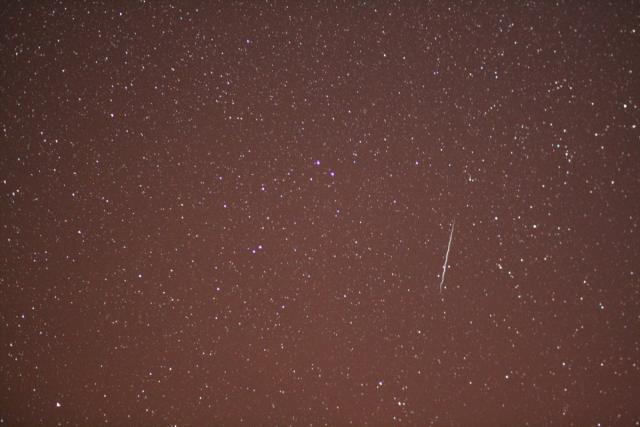
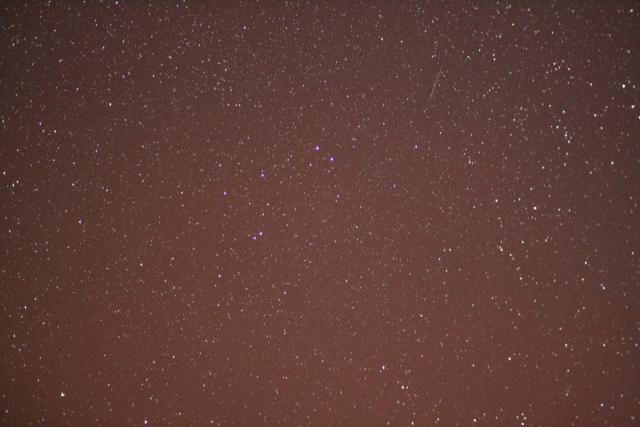
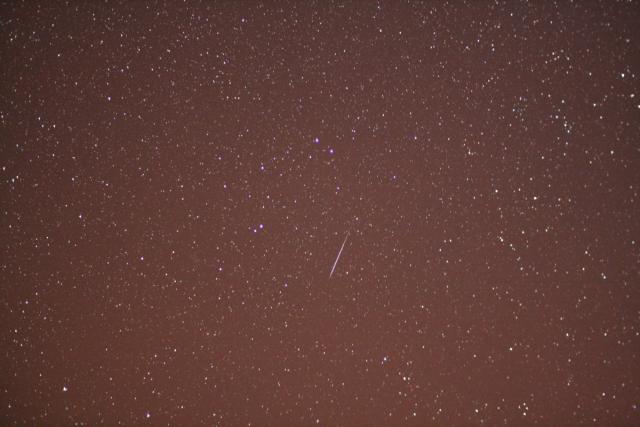
 Bill WardParticipant
Bill WardParticipantHi,
Yep it’s a curious effect all right. On twitter I’ve been presented with many explanations and reasons. The first night I was observing it was so windy I elected not to use the DSLRs for this very reason, 2nd night (peak) was much less windy although there were some short spells of gusty winds and the 3rd night was fairly windy again (but I haven’t got to checking all of the third night images yet!).
What would clinch it would be some double station imaging with suitably placed cameras. I’ll just need to go back to do some more imaging…. 😉
cheers,
Bill.
 Bill WardParticipant
Bill WardParticipantHi Eric,
I hope you join in, it’s a fasciating aspect of meteor observing!
Cheers,
Bill.
 Bill WardParticipant
Bill WardParticipantHi,
Although the document is referencing solar observing have a look at this: http://www.spectrohelioscope.org/net/spectro.pdf
It’s essentially the same design as Cristian Buils work (a Littrow is a Littrow….) but using very basic components. I built this out of thin plywood and other scrap. I even used the objective from and old pair of binoculars, just like the spec and the only thing I bought was a “b” grade grating from Edmund Optics. It worked brilliantly! I even used it in demos about spectroscopy. You could beef up the design for telescope mounting without too much difficulty but without a way to view the slit it’s akward to use for stellar astronomy ( I tried and gave up…).
Anyway, it’s a very basic and cheap way to start.
cheers,
Bill.
29 November 2017 at 9:14 pm in reply to: Meteor Spectra 2017 Nov – I87 Astroshot Observatory #578822 Bill WardParticipant
Bill WardParticipantGreat stuff! Glad to see more spectro stations getting results now.
Whats the set up (lens/grating?)
cheers,
Bill.
 Bill WardParticipant
Bill WardParticipantHi,
Thanks Alex, further to my email about Nemetode, since I first pointed a watec camera at the sky in winter of 2005/2006, revolution is the only word to describe whats been going on in meteor astronomy over those years. Next year, will be a decade of meteor spectrosopy from my place. I enjoy reading old astronomy books and my latest one, from the late 50’s has the line “meteor spectroscopy is the greatest challenge, there are no more than a few score of specta available to researchers…it is nearly impossible to identify individual lines…” The other really curious thing from that book is a table one line of which states that only 2% of meteors show lines of sodium. The hundreds that I now have show the exact reverse! there are very few that DON’T show sodium. I use it as one of the standard markers! How times change…
Roll on the Geminids but I’m going to try and not break any more bones on my way to observing!
cheers,
Bill.
 Bill WardParticipant
Bill WardParticipantHa ha! when I saw the various graphics for it Rendevous with Rama was the very first thing I thought of!
 Bill WardParticipant
Bill WardParticipantBy way of a comparison here’s the Leonid composite spectrum image and the best Lyrid one I got this year.
The change in velocity certainly affects the ablation heights and thus the appearence of the 557.7nm forbidden O Line.
(I’m hoping Alex will have some info on the heights of the Lyrids as determined by the Nemetoders…)
This line is a very useful rough and ready diagnostic tool!
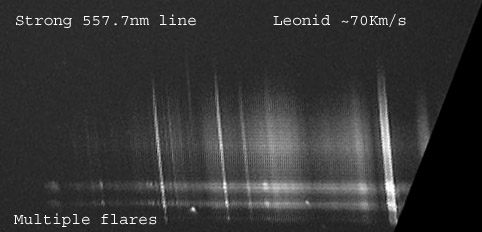

cheers,
Bill.
 Bill WardParticipant
Bill WardParticipantHi,
That is excellent news, I wonder what the final flare mag would have been. I’d have thought it brighter than -1.5 to give the spectrum it did. Applying my own principles of comparative spectroscopy I overlaid Williams and my own and the correspondance is excellent.
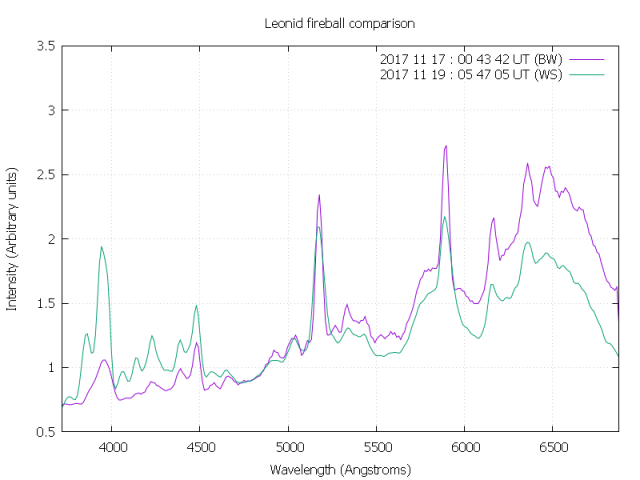
The varying gradients are due to flat field calibration issues. I’ll need to investigate this a bit more however it was an interesting catch with the rapid changes to the metal lines over essentially a single frame.
Seeing your fov I’ll try lowering my camera a bit, They’re all quite high to avoid light pollution diffraction issues, I’ll see if I can get a way with it.
I’m a bit dissapointed I never caught a thing with my dslr rig. I had thw two cameras with the LC shutters on for 8 hours! There were a few periods with some high cloud but 16/17 turned out to be a decent nights observing.
Cheers,
Bill.
 Bill WardParticipant
Bill WardParticipantThanks to the efforts of Mike and William this is looking like a good candidate. Whilst there is still a timing issue on my part the az and alt of my camera are in the correct direction.
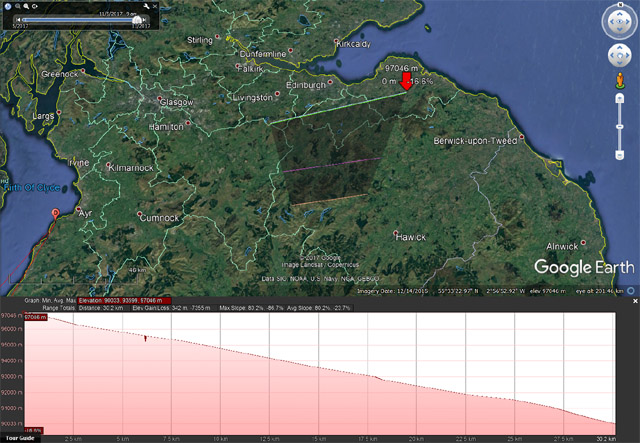
Due to resizing the image to fit it’s a bit difficult to see the numbers on the graphic. The meteor trail starts at 97 km and decends to 90km over a 30km path.
Image courtesy of Mike Folan.
cheers,
Bill.
 Bill WardParticipant
Bill WardParticipantHi,
Perhaps not “confident” as there is still a timing error but the trail length and relatively slow speed make it “definite” maybe….
Certainly was travelling in the correct direction for a possible N Taurid.
cheers,
Bill.
 Bill WardParticipant
Bill WardParticipantHi,
The shutters were supplied by this company.
However, I got mine via a friend in the Netherlands as he was ordering several for the same use. I don’t know for sure but there may have been a minimum order quantity. A single shutter is around Euro 200-250 depending on model.
cheers,
Bill.
-
AuthorPosts
